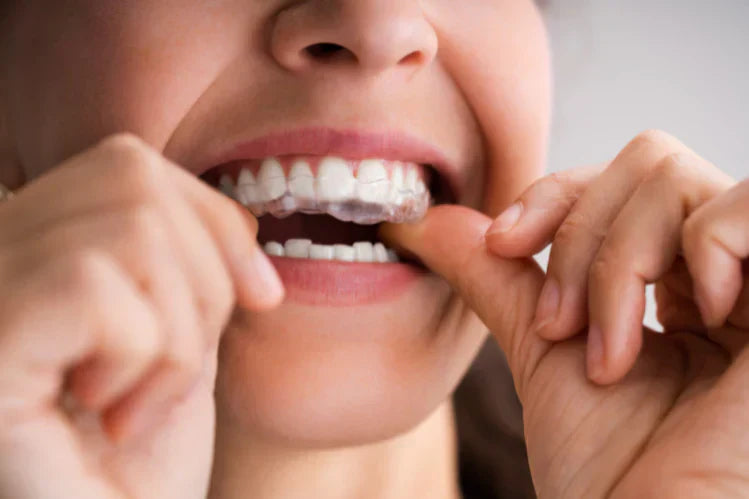
A straighter, radiant smile has never been more accessible thanks to the rise of teeth aligners. Traditional braces are the oldest method for teeth alignment. However, over time, aligners have become a preferred choice due to their discreet and comfortable approach to straightening teeth. Since teeth aligners have become immensely popular among individuals of all ages, different brands now offer aligners. But with varied options, you must be wondering which brand offers the Best Teeth Aligners in Australia.
What are Teeth Aligners
Teeth aligners are orthodontic devices used for teeth alignment and are commonly referred to as clear aligners. They are transparent trays composed of plastic material to exert gentle pressure on the teeth. Unlike traditional braces, teeth aligners are not fixed on the tooth surface. Since they are made of plastic, they are barely visible compared to metal ones. Teeth aligners can be used for treating misalignments like crowding, overbite, underbite, tooth gaps, edge-to-edge bite, etc.
Key Factors to Get the Best Teeth Aligners
Material and Durability
Your smile transformation doesn’t have to come at the cost of your health. No matter what brand you opt for, your health should always be a priority. You should check the brand’s reviews and do your research as well to know whether the composition is safe and smooth to begin your smile transformation.
Affordability
Teeth straightening treatments are often considered a luxury. However, this isn’t the case every time. You must check for different brand options to know what they are offering and at what cost. Your smile makeover should not break the bank. Pick a brand that is a blend of both affordability and durability. Some brands also offer installment plans that help to keep your transformation within the budget.
Smilepath Clear Aligners

If you are looking forward to the best clear teeth aligners in Australia, Smilepath has got you covered. A brand where durability meets affordability. You can choose from our varied clear aligner plans. For instance, for fast results, choose our all-day aligner plan. On the other hand, if you want to skip the daytime hassle, choose our night-only clear aligner plan.
Why Choose Smilepath?
Cost Effective
Who says teeth straightening has to be a luxury? With Smilepath Clear Aligners , you can get your teeth straightened within your budget.
At Home Aligners
Smilepath offers at home teeth straightening, which means no need to wait for long clinic visits and appointments. From initial assessment to getting your fabricated aligners, everything is done from the comfort of your home.
Treatment Options
At Smilepath, we offer varied treatment options. If you want to straighten your teeth during the day, choose our all-day aligner plan. On the other hand, if you have a public-facing job, you can skip the daytime hassle and choose our night-only aligner plan.
Durable Composition
Our clear aligners are composed of BPA-free material, which ensures to provide you with a smooth journey. Moreover, the aligners are customized to meet each individual’s dental requirements.
Benefits of Teeth Aligners
Invisible Transformation
One of the major aspects of clear aligners that has made them a preferred teeth straightening option is their invisible nature. They are barely seen and ideal for individuals who do not want to have any compromise to their appearance.
Faster Treatment
Compared to metal braces, teeth aligners provide faster and more effective straightening results. The average treatment duration to achieve your desired results with aligners ranges between four to six months, depending on the severity of the case.
Easy to Remove
Teeth aligners are not fixed on the teeth, which gives you the freedom to remove them whenever you want. Metal braces make eating challenging since they are attached to the tooth surface. Whereas aligners can be removed without the supervision of an expert. You can take them off and enjoy your regular meals whenever you want.
Oral Hygiene
Metal brackets often make it challenging to ensure proper oral hygiene, leading to the development of bacteria and plaque. However, aligners can be removed to keep your oral hygiene on track.
The Best Teeth Aligners for You
Teeth straightening has never been this easy thanks to teeth aligners. They have emerged as a popular option for correcting teeth alignment for people with mild and moderate dental issues. There are a number of brands that offer clear teeth aligners. However, if you are looking for a credible option for straightening your teeth in Australia, Smilepath has you covered. The at-home, affordable, and durable clear aligners can help straighten your teeth in no time.
FAQs
Yes, $8,000 is costly for a clear aligner treatment. Smilepath offers affordable teeth straightening plans starting from just $1,270.
Clear aligners are best recommended for mild to moderate dental misalignments. If an individual is suffering from a severe dental issue, their orthodontist might recommend other treatment options.
Clear aligners usually take four to six months to align teeth. However, it also depends on the severity of the case.
Yes, Smilepath offers teeth straightening from the comfort of your home. Moreover, you can enjoy affordable treatment plans to align your teeth.
References
Anand, E., DDS. (2024, October 10). Best Invisible Braces for Adults. EverydayHealth.com. https://www.everydayhealth.com/dental-health/best-invisible-braces/
Teeth straightening options for adults | HCF. (n.d.). https://www.hcf.com.au/health-agenda/health-care/treatments-and-procedures/teeth-straightening-options





 Australia
Australia New Zealand
New Zealand Malaysia
Malaysia English
English Portuguese
Portuguese English
English English
English English
English English
English English
English Canada
Canada